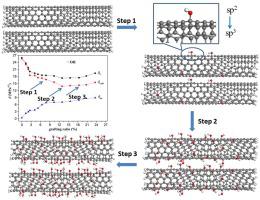当前位置:
X-MOL 学术
›
Comp. Mater. Sci.
›
论文详情
Our official English website, www.x-mol.net, welcomes your feedback! (Note: you will need to create a separate account there.)
Precisely tailoring the thermodynamic compatibility between single-walled carbon nanotubes and styrene butadiene rubber via fully atomistic molecular dynamics simulation and theoretical approach
Computational Materials Science ( IF 3.3 ) Pub Date : 2021-01-01 , DOI: 10.1016/j.commatsci.2020.109995 Yanlong Luo , Xianling Chen , Haobei Liu , Hao Zhang , Meng Song , Jun Liu , Zhenyang Luo
Computational Materials Science ( IF 3.3 ) Pub Date : 2021-01-01 , DOI: 10.1016/j.commatsci.2020.109995 Yanlong Luo , Xianling Chen , Haobei Liu , Hao Zhang , Meng Song , Jun Liu , Zhenyang Luo

|
Abstract From the perspective of thermodynamics, the compatibility between filler and matrix determines the dispersion and morphology of filler and further determines the final properties of composites. At present, it is difficult to obtain a quantitative relationship between the surface chemistry of filler and compatibility with matrix through experimental means. In this study, the quantitative relationship between functional groups and Hildebrand (δT) and two-component solubility parameters (δvdW, δele) of single-walled carbon nanotubes (SWCNTs) was obtained by molecular dynamics (MD) simulation. The most notable conclusion is that with the increase of grafting ratio, the δT and δvdW of SWCNTs first decrease, reach a minimum and then increase. This regularity makes the SWCNTs with different functional groups exhibit different compatibility behaviors with styrene butadiene rubber (SBR), resulting in different functionalization principles for different groups. Two-component solubility parameters of SWCNTs and SBR were further proved to be able to predict well their compatibility by Flory-Huggins model. Each functional group has the optimum grafting ratio at which the compatibility is the best. Additionally, the –CH3, –CH(O)CH– and –OH functionalized systems exist the optimum temperature for the best compatibility. The multifunctional groups is superior to a single group for the compatibility. This study provides a quantitative guidance for the functionalization of SWCNTs towards the good compatibility with SBR.
中文翻译:

通过全原子分子动力学模拟和理论方法精确定制单壁碳纳米管和丁苯橡胶之间的热力学相容性
摘要 从热力学角度看,填料与基体的相容性决定了填料的分散性和形貌,进而决定了复合材料的最终性能。目前,很难通过实验手段获得填料表面化学性质与与基体相容性之间的定量关系。本研究通过分子动力学(MD)模拟获得了单壁碳纳米管(SWCNTs)的官能团与希尔德布兰德(δT)和双组分溶解度参数(δvdW、δele)之间的定量关系。最显着的结论是随着接枝率的增加,SWCNTs的δT和δvdW先减小,达到最小值,然后增大。这种规律性使得不同官能团的单壁碳纳米管与丁苯橡胶(SBR)表现出不同的相容性,导致不同官能团的官能化原理不同。通过 Flory-Huggins 模型进一步证明 SWCNTs 和 SBR 的双组分溶解度参数能够很好地预测它们的相容性。每个官能团都有最佳的接枝率,在该比例下相容性最好。此外,–CH3、–CH(O)CH– 和–OH 官能化系统存在最佳温度以实现最佳兼容性。多功能基团的相容性优于单一基团。该研究为 SWCNT 的功能化以实现与 SBR 的良好兼容性提供了定量指导。导致不同组的不同功能化原则。通过 Flory-Huggins 模型进一步证明 SWCNTs 和 SBR 的双组分溶解度参数能够很好地预测它们的相容性。每个官能团都有最佳的接枝率,在该比例下相容性最好。此外,–CH3、–CH(O)CH– 和–OH 官能化系统存在最佳温度以实现最佳兼容性。多功能基团的相容性优于单一基团。该研究为 SWCNT 的功能化以实现与 SBR 的良好兼容性提供了定量指导。导致不同组的不同功能化原则。通过 Flory-Huggins 模型进一步证明 SWCNTs 和 SBR 的双组分溶解度参数能够很好地预测它们的相容性。每个官能团都有最佳的接枝率,在该比例下相容性最好。此外,–CH3、–CH(O)CH– 和–OH 官能化系统存在最佳温度以实现最佳兼容性。多功能基团的相容性优于单一基团。该研究为 SWCNT 的功能化以实现与 SBR 的良好兼容性提供了定量指导。每个官能团都有最佳的接枝率,在该比例下相容性最好。此外,–CH3、–CH(O)CH– 和–OH 官能化系统存在最佳温度以实现最佳兼容性。多功能基团的相容性优于单一基团。该研究为 SWCNT 的功能化以实现与 SBR 的良好兼容性提供了定量指导。每个官能团都有最佳的接枝率,在该比例下相容性最好。此外,–CH3、–CH(O)CH– 和–OH 官能化系统存在最佳温度以实现最佳兼容性。多功能基团的相容性优于单一基团。该研究为 SWCNT 的功能化以实现与 SBR 的良好兼容性提供了定量指导。
更新日期:2021-01-01
中文翻译:

通过全原子分子动力学模拟和理论方法精确定制单壁碳纳米管和丁苯橡胶之间的热力学相容性
摘要 从热力学角度看,填料与基体的相容性决定了填料的分散性和形貌,进而决定了复合材料的最终性能。目前,很难通过实验手段获得填料表面化学性质与与基体相容性之间的定量关系。本研究通过分子动力学(MD)模拟获得了单壁碳纳米管(SWCNTs)的官能团与希尔德布兰德(δT)和双组分溶解度参数(δvdW、δele)之间的定量关系。最显着的结论是随着接枝率的增加,SWCNTs的δT和δvdW先减小,达到最小值,然后增大。这种规律性使得不同官能团的单壁碳纳米管与丁苯橡胶(SBR)表现出不同的相容性,导致不同官能团的官能化原理不同。通过 Flory-Huggins 模型进一步证明 SWCNTs 和 SBR 的双组分溶解度参数能够很好地预测它们的相容性。每个官能团都有最佳的接枝率,在该比例下相容性最好。此外,–CH3、–CH(O)CH– 和–OH 官能化系统存在最佳温度以实现最佳兼容性。多功能基团的相容性优于单一基团。该研究为 SWCNT 的功能化以实现与 SBR 的良好兼容性提供了定量指导。导致不同组的不同功能化原则。通过 Flory-Huggins 模型进一步证明 SWCNTs 和 SBR 的双组分溶解度参数能够很好地预测它们的相容性。每个官能团都有最佳的接枝率,在该比例下相容性最好。此外,–CH3、–CH(O)CH– 和–OH 官能化系统存在最佳温度以实现最佳兼容性。多功能基团的相容性优于单一基团。该研究为 SWCNT 的功能化以实现与 SBR 的良好兼容性提供了定量指导。导致不同组的不同功能化原则。通过 Flory-Huggins 模型进一步证明 SWCNTs 和 SBR 的双组分溶解度参数能够很好地预测它们的相容性。每个官能团都有最佳的接枝率,在该比例下相容性最好。此外,–CH3、–CH(O)CH– 和–OH 官能化系统存在最佳温度以实现最佳兼容性。多功能基团的相容性优于单一基团。该研究为 SWCNT 的功能化以实现与 SBR 的良好兼容性提供了定量指导。每个官能团都有最佳的接枝率,在该比例下相容性最好。此外,–CH3、–CH(O)CH– 和–OH 官能化系统存在最佳温度以实现最佳兼容性。多功能基团的相容性优于单一基团。该研究为 SWCNT 的功能化以实现与 SBR 的良好兼容性提供了定量指导。每个官能团都有最佳的接枝率,在该比例下相容性最好。此外,–CH3、–CH(O)CH– 和–OH 官能化系统存在最佳温度以实现最佳兼容性。多功能基团的相容性优于单一基团。该研究为 SWCNT 的功能化以实现与 SBR 的良好兼容性提供了定量指导。



























 京公网安备 11010802027423号
京公网安备 11010802027423号